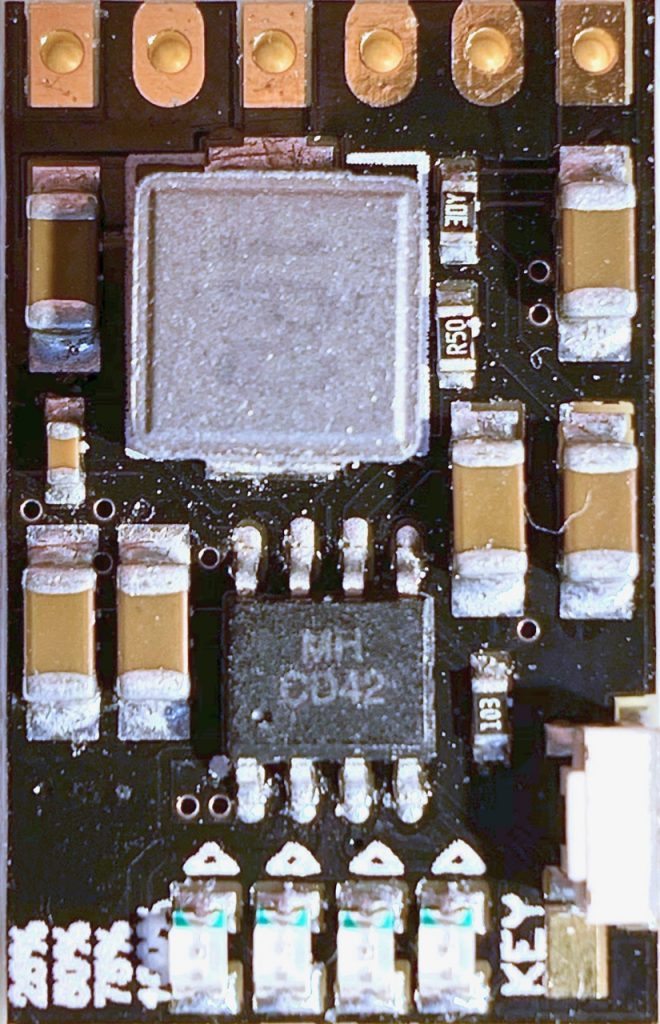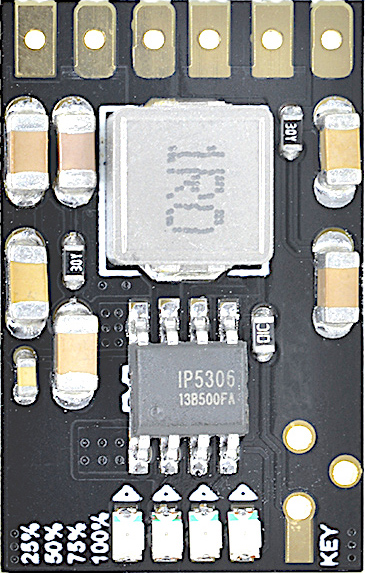I just received a USB / LiIon power module I paid ~$2, including shipping, for on AliExpress. The model is given as MH-CD32 (link goes to what I think is the original manufacturer, though I purchased it from another seller with cheaper shipping).
The board is supposed to be an all-in-one solution for powering a 5v (ie USB powered) device from a lithium ion battery pack. I suspect the IC was originally designed for use in a USB powerbank. The basic features are:
- Charging of 3.7v nominal, 4.2v max, lithium ion batteries.
- 5v charging input, 2.1A max charing current
- Battery protection for over current, over voltage and over temperature (for the charging IC, at least, there is no provision for a thermistor to sense pack temperature)
- 5v output, up to 2.1A
- 4-level battery “fuel gauge”
- Power path management: when the module is externally powered, it can power the load and charge the battery with any excess power from the supply.
- Control input that can switch the output on, or off, suitable for control by a microcontroller.
- 100uA quiescent current.
It accomplishes this all with a single 8-pin IC, a dozen discrete passives (an inductor, eight ceramic capacitors, three resistors), four LEDs and a microswitch. All in all, it looks like a useful module.
I’m curious about what IC it uses. The package has markings, but they aren’t useful; it’s marked MH CD42, which is the model number of the module. Nothing strange about that, except that Google searches don’t turn up anything, no Chinese datasheets, just more product listings for the module.
Ordinarily, the first couple of letters of a chip marking echo the name of the manufacturer, but in this case, they instead they echo the name of the module manufacturer “MH-ET.” It isn’t uncommon that manufacturers “sand” the IC package to obscure it’s origin. In this case though, it seems that MH-ET has either remarked the chips or, more likely, had the packages custom marked.
If I were a competitor, and this were a product that had some combination of a large market, a high margin and a high selling price, I could go to great lengths to discover the true origin of the integrated circuit. I’d start by gathering the basic details of the product and using that to infer the specs of the IC. There isn’t much guess work in this case, because the product is a manifestation of the the capabilities of the IC, and its typical for the sellers to use the ICs specs when describing the module, even when the implementation cuts corners that may compromise the specs.
I’d use the specs I gathered to search catalogs and databases for similar ICs and compile a list of candidates. If my goal is to produce a competitive product in terms of cost and capabilites, I’d investigate pricing of the candidates and if any of them met the functional and cost requirements, that might be the end of it.
If I couldn’t find an equivalent chip, or if I wanted to improve my negotiating postion, or if I was involved in making or selling a competing IC, I’d dig deeper. I’d look more closely at the details of the IC, the specific package, the functions of each pin, the details of the circuit connected to each pin and I’d compare them to the documentation available for candidates I’d previously identified based on basic specifications.
Beyond that, I could order samples of the candidates and test their behavior against that of that of samples of the unknown chip. Or, perhaps I’d use chemical or mechanical means to extract the silicon ship from the enclosing package and then examine it under a microscope before and after stripping away layers of metalization on the IC. This might show me markings like a date code, part number, or logo. It would certainly show me the gross and fine structure of the circult. All of them would help me find the true origin of the integrated circuit.
I’m not going to do that though, in fact, I’ve already spent more time writing about it than I’d like to spend on what I am going to do.
Rather than going to those lengths, I’m going to take a shortcut that I happen to have available to me: I remember seeing a similar module on eBay a few months ago and I remember that the IC on that module had a distinct an unfamiliar manufactuer logo on it.
It took a little longer than I expected, but I found the ebay listing, or one like it. There IC lacks a distinctinve logo, but it does have a clear part number “IP5306,” and that part number leads to a catalog listing on a distributor’s site, a datasheet and the manufactuer, a company called Injoinic Technology.
The PCB layouts are very similar. The IC pinouts seem identical. I tried tracing out the circuit, but I could only get so far without removing components. The only real question are pins 6 & 7.
My 4.5 digit multimeter shows ~0Ohms resistance between them, suggesting they are on the same node of the circuit. However, if the IC on my MH CD42 board is the same or equivalent to the one on the IP5306, then those pins should actually be on two separate nodes of the circuit. Pin 7, on the left, should be connected directly to the near side of the inductor, while pin 6 should be connected to the far side of the inductor, by way of the low-value 500mOhm resistor you can see in the photograph.

It wouldn’t be hard to pull off some components and replace them later, or it shouldn’t be, but I always seem to hit a snag on the easy jobs, like loosing a tiny component, or delaminating part of a trace. Fortunately, I have a nice Keithley 2000 6.5 Digit DMM. It’s serious overkill for most stuff, and measuring miliohms isn’t its forte, but it only took 30s to boot up (it actually has a Motorola 68030 process, like an old Mac ][, or SE/30 computer), and less time than that to show that the path from Pin 6 to Vbatt had 500mOhm higher resistance than the path from Pin 7.
So, my conclusion is that the MH CD42 IC is actually an Injoinic Technology IP5306. It’s possible that it is a “clone,” or that they both actually come from a third party, or are otherwise derived from the masks and foundry. It may also be true that there is another IC on the market that defined the specs and pinout and that a very narrow market niche has emerged around it. I already know more than I need to know, and if you’ve read this far, then you know it, too.

